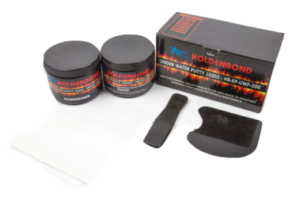
Description:
A unique, non‐rusting, high exothermic epoxy for repairing, patching and rebuilding equipment in chronically wet environments ‐ even under water.
Recommended Applications:
· Repairing and fitting pipes, valves, pumps, tanks and other equipment in marine environments, offshore drilling, water treatment plants and paper and pulp mills
· Repairing concrete pipes and vessels in wet environments.
Surface Preparation:
Proper surface preparation is essential to a successful application. The following procedures should be considered for dry applications:
· All surfaces must be dry, clean and rough.
· If surface is oily or greasy use HOLDENBOND ® Fast Cleaner 2000 / Cleaner Blend 300 to degrease the surface.
· Remove all paint, rust and grime from the surface by abrasive blasting or other mechanical techniques.
· Aluminium repairs: Oxidation of aluminium surfaces will reduce the adhesion of an epoxy to a surface. This film must be removed before repairing the surface, by mechanical means such as grit‐blasting or chemical means.
· Provide a “profile” on the metal surface by roughening the surface. This should be done ideally by grit blasting (8‐40 mesh grit), or by grinding with a coarse wheel or abrasive disc pad. An abrasive disc may be used provided white metal is revealed. Do not ‘feather edge’ epoxy materials. Epoxy material must be ‘locked in’ by defined edges and a good 3 ‐ 5 mil profile.
· Metal that has been handling sea water or other salt solutions should be grit blasted and high pressure water blasted and left overnight to allow any salts in the metal to ‘sweat’ to the surface. Repeat blasting may be required to ‘sweat out’ all the soluble salts. A test for chloride contamination should be performed prior to any epoxy application. The maximum soluble salts left on the substrate should be no more than 40 ppm. (parts per million).
· Chemical cleaning with HOLDENBOND ® Cleaner Blend 300 should follow all abrasive preparation. This will help to remove all traces of sandblasting, grit, oil, grease, dust or other foreign substances.
· Under cold working conditions, heating the repair area to 38ºC ‐ 43º C immediately before applying any of HOLDENBOND ® Epoxies is recommended. This procedure dries off any moisture, contamination or solvents and assists the epoxy in achieving maximum adhesion to the substrate.
· Always try to make the repair as soon as possible after cleaning the substrate, to avoid oxidation or flash rusting. If this is not practical, a general application of FL‐10 Primer will keep metal surfaces from flash rusting.
For underwater or submerged repairs consider the following:
· Remove all dirt, barnacles, flaking paint and algae/seaweed from the substrate
· Wipe area with a clean cloth to remove any film on the surface. You cannot degrease underwater, but wiping and turning a clean cloth will often remove any film on the surface.
· Abrade the surface if possible (use mechanical means or a file to accomplish)
· The oxidation can be removed by mechanical means such as water, grit‐blasting or by chemical means.
· Make the repair as soon as possible to avoid surface contamination.